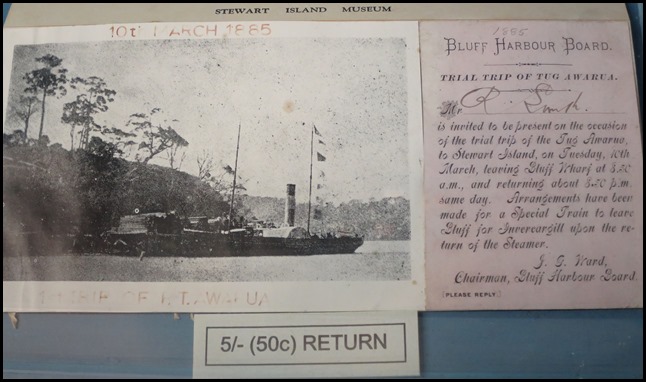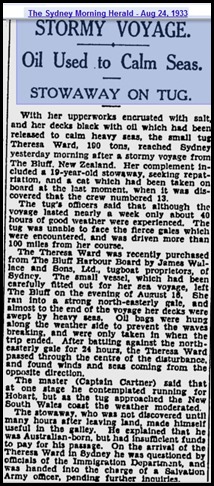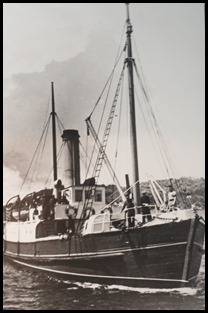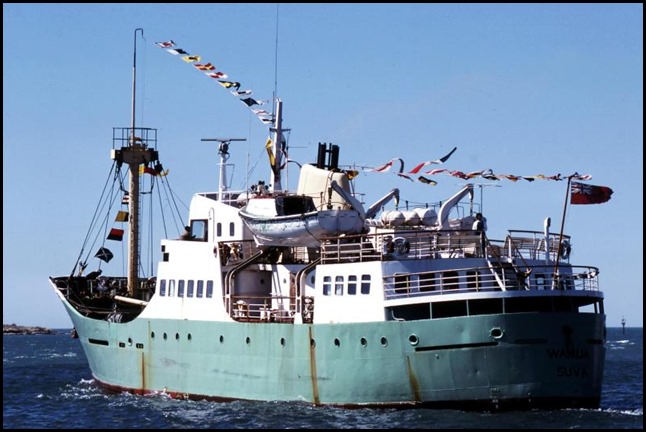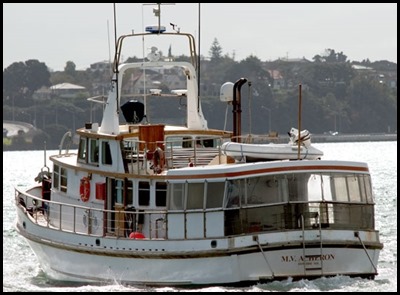Stewart Island Ferry

|
The Stewart Island
Ferry  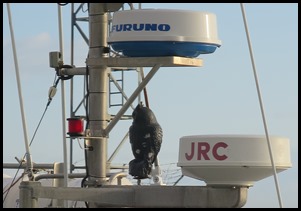 This morning we jumped up with the alarm,
moved Mable to the harbour car park at Bluff fifteen minutes away, ate our
breakfast, made our sandwiches and checked in at nine for our nine thirty
crossing to Stewart Island. The Fovreaux Express II waiting quietly for
her journey. Bear was absolutely thrilled to see The Wise
Owl watching over all things. The ferry, a
fast catamaran, captained by Ivan, was soon on her
way. This purpose built lady trots along happily at twenty seven knots. Not sure
we could handle all those levers and throttles, so we
sat back to enjoy the hour long crossing. There were three French youngsters,
the male of the group had spoken constantly and very loudly in the waiting room
so we planned to sit as far as we could away from the constant babble. There was
a lone chap, hat pulled down. A lady and her dad. Matt the crew came over to chat, coming from Stewart Island he gave
us top tips on what to see and told us the first place to go was the Red Hut.
There we could book a water taxi to Ulva Island – a must do, and the bus tour
for tomorrow. That was nice of Matt to spend so long
with us. Bear was at the front and oblivious to what was happening
rearward. The young Frenchman had swaggered to
the front to look at tourist brochures, after the first big wave he soon sat in
his seat. The two young ladies with him faded soon enough with the first testing
the ‘little white bags’ five minutes out, the second following five minutes
later, the stewardess cheerfully swapping ‘little white bags’ and redirecting
the air-con. Young Frenchman now severely hunkered down in his seat, absolutely
silent with ‘rabbit in headlights’ stare. Hat pulled down remained motionless
and emotionless but an imaginary ‘do not disturb’ look about him. The lady, eyes
like an owl was gripping the seat in front of her and her dad had his eyes tight
shut,also gripping the seat in front of him. So in fact, Matt didn’t have too
much of a selection left – just us. I thought it was
hysterical the first, second and third time my bottom left the seat. Ivan
described the sea as “sloppy with thirty six knot gusts and waves he had to
steer round.”
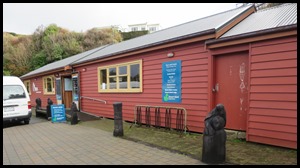  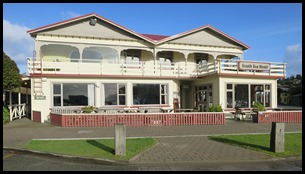 Exactly an hour later we pulled in to
Halfmoon Bay and off we bimbled to the Red Hut.
Weather due to be better this afternoon, so we booked our water taxi for eleven
o’clock today to Ulva. We just had time to check in, settle Beds in our basic, but very clean room, complete with
electric blanket at the South Sea Hotel and walk the
ten minutes over the hill to find Ian our water taxi chap. Marvelous.
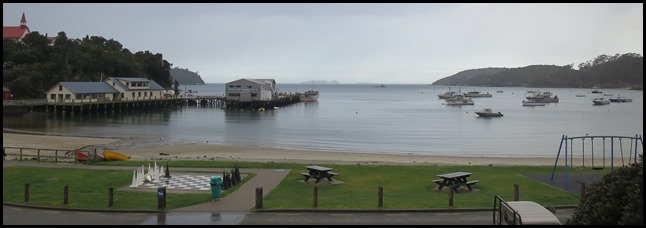 The view of Halfmoon Bay from the communal
lounge with complimentary tea and coffee. Looking out at the calm, quiet water
in the sheltered harbour belied how rough it was out in the Fovreaux Strait. It
begged the question as to how the ferries of old managed the ‘one of the world’s
lumpiest ferry crossings’. We would find out some of the history in the Museum,
the list and pictures of some of the past ladies.
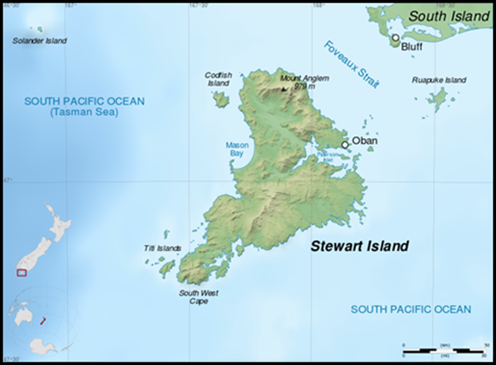 It has often been said that catching the ferry to
Stewart Island without leaving a part of you somewhere in Foveaux Strait is a good crossing. This strait has been
stroppy from the start. "Whirlpools are frequently to be met
with and the position is one of great peril when the direction of the waves is
contrary to that of the wind," Jules de Blosseville wrote in 1823, but Maori
already knew about the wind. They called it hau-mate or death wind.
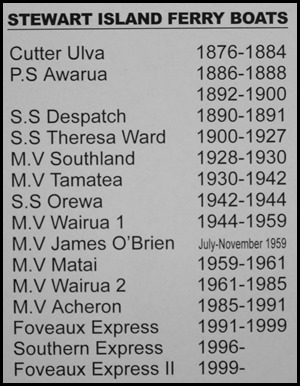 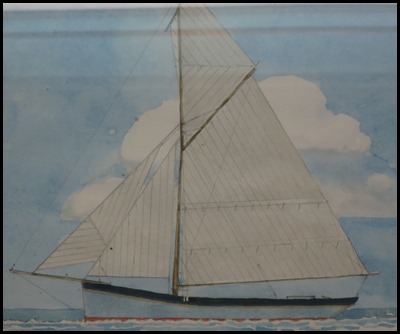 The list of ladies and the very first ferry -
Ulva. Tom
Leask and Dennison “Yankee” Smith built her at Sydney Cove, Ulva Island for
Charles Traill in 1876. She was an eighteen ton wooden cutter, forty two feet
nine inches in length and fifteen feet six inches wide. She was used as a mail
carrier, making the weekly crossing between Bluff and Stewart Island from 1877
until the end 1884 under the command of William Joss. Charles Traill owned her
from 1876 to 1880, then sold her to William Joss, who owned her from 1880 to
1888. In 1901, while on Barker and
Jones’ slip she was broken up.
The skipper of the first ferry in 1877, William Joss, was said to take pride in sailing to schedule whatever the weather. When a larger vessel was needed in 1885, the paddle steamer, Awarua, took over. Its first crossing wasn't a good one. About a hundred and thirty invited guests were welcomed on the Bluff wharf by the Invercargill Garrison Band. But no sooner had the Awarua entered Foveaux Strait than most passengers regretted having a "sumptuous" breakfast. They didn't arrive back in Bluff until 9pm. The hundred ton paddle steamer Awarua operated from 1886 to 1888 and from 1892 until 1900. Sadly, she was totally wrecked at Kauri Mountain, near Whangarei Heads, on the 6th of February 1907. The steamer had coaled at Whangarei, and went to Kaiiri Mountain for a raft of logs. When about half a mile offshore she struck an uncharted rock. A heavy surge was on at the time, and the rocks penetrated the bottom of the vessel, which was soon full of water. The tugboat Pelican was despatched by the Devonport Ferry Company, owners of the Awarua, and the vessel was stripped of everything of value. The place where the Awarua struck is known as the Fanny Kelly Reef, the ketch Fanny Kelly having been totally wrecked there on the 3rd of February 1886, with the loss of four lives. The Court of Inquiry found that the Awarua was in charge of an A.B., the master being engaged in a mate's duties, when she struck on an uncharted rock and became a total wreck, one mile from Kauri Mountain. The court considered that the master should have been warned of rocks in the vicinity of his course. The Awarua, No. 57,650, was an iron, paddle steamer of 159 tons gross and 100 tons net register, built at Blackwall, England, in 1884, her dimensions were: length 109.8 feet, beam 20.3 feet, draught 10 feet. Her engines were of 32 h.p. Captain L. A. McLean commanded the steamer. The sixty five feet screw steamer
Despatch which was the first steam oyster
boat used at Bluff, acted as a service boat to Stewart Island from 1890 until
1892.
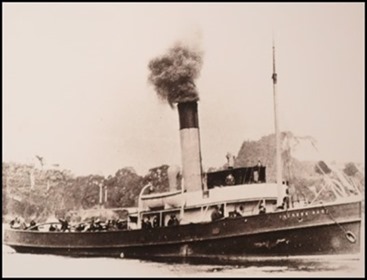 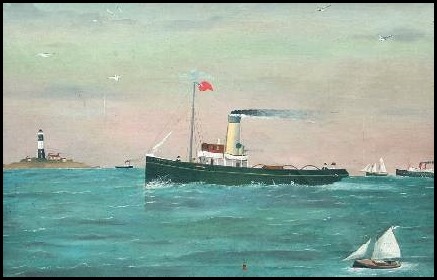 The Theresa
Ward built in Britain in 1900 and named for Lady Ward, wife of Sir
Joseph, Chairman of the Bluff Harbour Board and later Prime Minister of New
Zealand. This tug operated the ferry service for twenty seven years,
then crossed the Tasman in 1933 to new owners in Sydney. She served them equally
well and it was not until the 4th of January 1960 when her registry was closed
and she was broken up.
An oil on canvas on board, was painted by Sir Joseph Ward
(1856-1931). He was known to have painted some other paintings in the same naive
style. Joseph Ward was chairman of the Bluff Harbour Board from 1883-1888 and
briefly again in 1893. He remained a member until 1917. Mayor of Bluff
1881 - 1886 and again 1897-98. Former Prime Minister, of New Zealand (1906–12,
1928–30). In 1883, 27 year old, Joseph married, 17 year old,
Theresa Dorothea De
Smidt, who was known for her beauty, elegance and huge extravagant hats. Theresa
is probably one of the figures depicted on the stern of the boat. The tug proved
her worth helping out following the grounding of the whale factory ship C.A.
Larsen.
Note.
The C.A.Larsen grounded on Whero
Island at entrance to Paterson Inlet on the 21st of February 1928. She came
off under own power; taken to shallow water off Ulva Island; patched and
refloated; small
loss of oil, majority transferred to the tanker Spinanger; in April was dry
docked at Port Chalmers for repairs. No loss of
life.
Otago Witness Wednesday 14 November 1900 The Bluff Harbour tug Theresa Ward arrived to-day from South Shields, after a passage of 75 days, including the time in port, at Adelaide, en route. Captain MacIntyre having no detailed chart of the straits, took the precaution to pick up a pilot off Riverton, before approaching the Bluff. The tug will be the most efficiently fitted in the colony, having salvage gear and a powerful pump and steam capstan for handling lines. Her length is 117ft, beam 22ft, and depth 12ft 6in. The engines are triple cylinders, 15½ in, 25 in, and 41 in, with 27in stroke. The boiler is fitted with three of Morrison's patent furnaces, and the working pressure is 180lb. On her trail her speed was 14 miles per hour, a fact which will be appreciated by visitors to Stewart Island. The builders were Messrs Rennoldson and Sons, of South Shields. Grey River Argus, 23 November 1900 - A Day at Bluff Invercargill, November 21. At Bluff harbour this afternoon, with some ceremony, Miss Eileen, daughter of the Hon. Mr. Ward, christened the new tug. 'Theresa Ward' just arrived from England. In the afternoon the Postmaster- General formally opened the Government Building at the port, which contain Post and Telegraph, Customs and other Department offices and later a procession was formed by the residents and visitors, the bands, volunteers, lodges and marched down the old Point road, now improved and named Ward Parade. After speeches, Mr. Ward declared the parade formally open to the public. This evening the Hon. gentlemen is being entertained at a banquet by the residents of Campbell town in honor of the day's doings. Otago Witness, 9 April 1902 - Harry's Southern Trip Next came the trip in the Theresa Ward to Stewart Island. And oh! didn't I enjoy that trip. I can safely recommend the s.s. Theresa Ward to everyone who wishes a lively time, and who likes to be "rocked in the cradle of the deep." Passing Dog Island and Mutton Bird Island, I caught my first glimpse of Stewart Island. We anchored in that superb harbour, Halfmoon Bay, and had such a short time in port The bush looked so tempting that a large number went to collect ferns, and returned to the boat covered with burrs and bid-a-bids. Sailing back to Bluff there was fairly heavy sea on, and more than one wave was shipped. Few of the passengers were not afflicted with mal-de-mer. I sat on the taffrail and laughed till my sides ached. The waves that came over washed two or three persons each time. I enjoyed the fun, and was sorry when we landed at the Bluff. The Sydney Morning Herald Thursday 3 August 1933 This afternoon Captain E Cartler and a crew of 12 men will leave Sydney by the RMS Makura to take delivery of the tug Theresa Ward which James Wallace and Sons, Ltd has purchased from the Bluff Harbour Board New Zealand, to replace the James Wallace recently sold to the Launceston Harbour Board. The Theresa Ward a steel tug of 195 tons gross with a 95 horse-power engine was built at South Shields in 1900 and is slightly larger and of greater power than the James Wallace. Captain Cartler's crew comprises Messrs J Archer (chief officer), A C Cartler (second officer), A R Grant, A S Addie and S Evans (engineers, a cook, four firemen, and two deck-hands. When the James Wallace goes to Launceston the tug Mybla will leave that port for Sydney, to enter the service of James Wallace and Sons, Ltd.
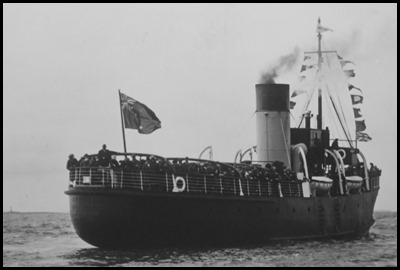
A great newspaper clipping. Southland 1928-1930.
Tamatea – formerly known as Blenheim, was brought to Bluff in 1930 and served the Stewart Island run until 1942. I could find nothing on the Orewa.
 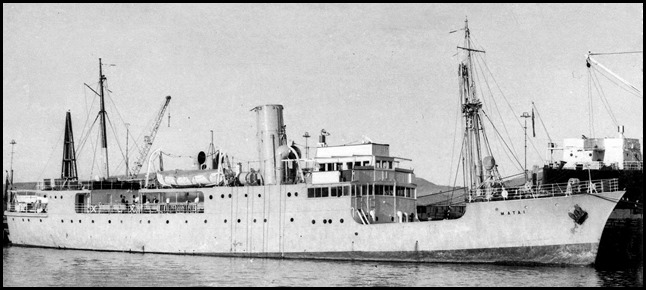
The Wairua I was built in Auckland, she was two hundred
and fifty tons and originally had a cutter rig. After alterations were made to
her by the Marine Department she served as the Stewart Island ferry from 1944
until 1959. There is a model of her made by Euan MacDonald that stands proudly
on display in the Museum, as does her steering wheel. James O’Brien, the Bluff tug took over the ferry service for a few months in 1959 until the Matai began her service. Named after the native New Zealand tree,
the Matai was
built by R. & W. Hawthorn-Leslie and Co. in Hebburn-on-Tyne, completed in
July 1930 and launched on the 6th of November 1930. As well
as servicing lighthouses, she was involved in laying cables in the 1930’s.
On the 3rd of March 1941 she was requisitioned by the New Zealand Navy and
commissioned as a minesweeper on the 1st of April 1941. Matai took
over as the flotilla leader of the 25th Minesweeping Flotilla from the Muritai and
the flotilla began clearing a German minefield in the Hauraki Gulf.
Decommissioning was on 25 April 1945.
The last of the Government ferries to service the island was Wairua II, which at the time of her construction in 1961 was the largest built in New Zealand. The hundred and fifty feet ferry was withdrawn from service in 1985 when the Government deemed it no longer economical to provide Stewart Island with a ferry service. She was sold to Interport Shipping of Fiji and was used as a ferry and freight service vessel to Rotuma, Fiji’s northern Polynesian outlier and the Tokelau Islands. Sadly she ended her life wrecked near Nai Koro Koro, Levuka, Fiji. The picture is of her last departure from Bluff.
Southern Express was built by Gough Bros. in 1996 Invercargill for Stewart Island Marine Ltd. She has an alloy catamaran hull and is licensed to carry sixty two passengers. She is used as a ferry and charter boat for the Stewart Island – Bluff run. Now owned by Real Journeys. Fovreaux Express II, our ferry, was built in Invercargill by Gough Brothers for Stewart Island Marine Ltd. She is also constructed of alloy, has a catamaran hull and can carry ninety seven passengers. Sold to Stewart Island Experience & Real Journeys in partnership, Real Journeys eventually bought out their partner’s share. Stewart Island Experience is a 100% owned subsidiary of
Real Journeys - a locally owned and respected New Zealand tourism company, which
has been operating in southern South Island for over fifty years.
Real
Journeys offers a range of other excursions including Milford
Sound, Doubtful Sound, Te Anau Glowworm Caves, Milford Track, TSS Earnslaw
Vintage Steamship, Walter Peak High Country Farm and Discovery Cruises. If you
book more than one journey they offer twenty per cent discount. Les Hutchins,
the company’s founder, had a lifelong interest and involvement in
conservation. His contribution to the environment continues through the
Leslie Hutchins Conservation Foundation established in 1994. The company sponsor and contribute to a number of initiatives
including: dolphin research, endangered bird protection, tracks and
interpretation signage, outdoor education camps and wilding pine eradication, Fiordland Coastal Clean Up, the Whio Blue duck
recovery programme, Pekapeka (native bats), the study of a rare gecko and many
more. At Milford Sound, Real Journeys employees are actively involved in
setting, baiting and checking stoat traps. The considerable effort put into
predator trapping has been well rewarded with birds returning in increasing
numbers and a more successful breeding season for the endangered Fiordland
Crested penguins.
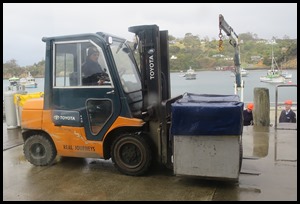 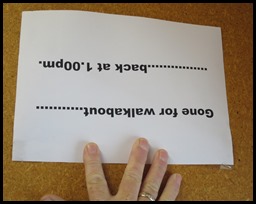 Our return journey began with us
checking in with a lovely young chap who immediately pulled his bobble-hat down
and went to work on the fork lift. Bear went for a
nozz and found the back of this sign funny.
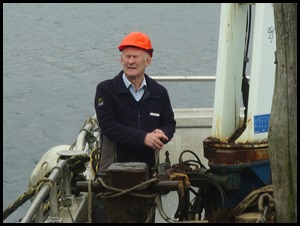 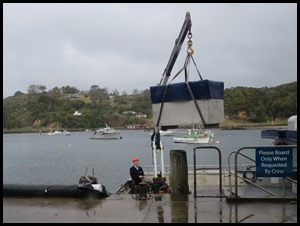 I watched as Ivan
the captain loaded.
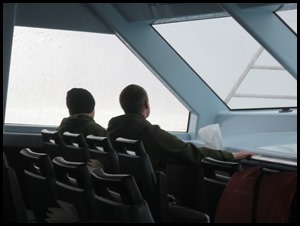  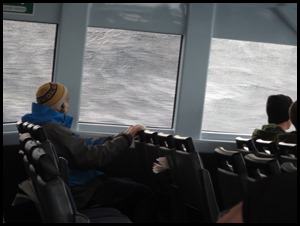 That done we
embarked for quite a journey. Ivan warned us that things would be
"rough
with winds
gusting fifty knots." The lads at the front sat down,
the one on the left got his 'white bag' ready, his friend made the Sign of the
Cross. As soon as we had left the shelter of Halfmoon Bay, the grey stuff heaped up, in no way would we want Beez Neez
in this little lot, but Ivan did incredibly well keeping us as ‘comfortable as
conditions allowed’. The chap behind the lads did
manage to let go of the handle long enough to take a few pictures. The view went
from thin air to sideways in a wave and back again. A lady at the back was
trying her best to bring her knee caps out through her body, felt very sorry for
her, rock and roll put on to cover the noise. We enjoyed the Bullers Albatross
cruising with us.
There
was a sign at the front really interesting, it had the usual seasickness advice
but there was a point about an earplug placed in the ear opposite your dominant
hand. Arrrrrmmmm that’s why there were earplugs in our
room at the hotel. Oh, I thought it was because they had been
pre-warned about your snoring.............
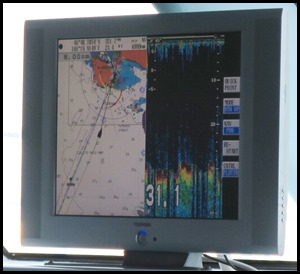 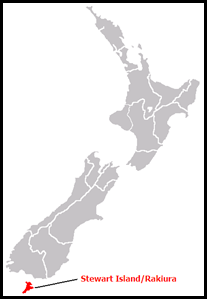
 The
thing is the Fovreaux Strait is only a hundred feet
deep, suffers big winds that don’t take long to heap the sea into a bit
of a mess. From Stewart Island to the nearest
landfall in Antarctica is a mere one thousand, five hundred and forty four
miles, don’t forget the point 107413, yes
dear. The next nearest landfall east or west at this level on the globe is Chile
some four thousand, six hundred and thirty nine miles. Back in the shelter of Bluff. Most on board thrilled to be
in.
.
ALL IN ALL GRAND
JOURNEYS
GRAND
INDEED |
